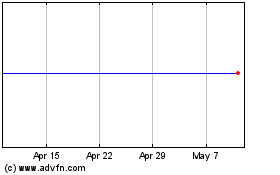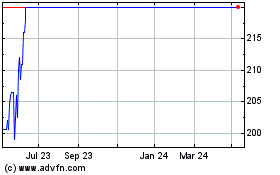Boeing Co Boeing to Recognize Q2 Charge for KC-46 Tanker Program
July 17 2015 - 7:34AM
UK Regulatory
TIDMBOE
Boeing to Recognize Charge for the KC-46 Tanker Program in Second Quarter
Company maintains commitment to U.S. Air Force delivery schedule
EPS guidance for 2015 to be updated on July 22
2015 cash and revenue guidance will remain unchanged
CHICAGO, July 17, 2015 -- The Boeing Company [NYSE: BA] announced today it will
recognize a charge on the KC-46 aerial refueling tanker program when it
announces second-quarter 2015 results on July 22.
The after-tax charge of $536 million ($0.77 per share) reflects higher
estimated engineering and manufacturing costs to complete development,
certification and initial production of the tanker aircraft, while holding to
the program schedule for initial production deliveries in 2017. The KC-46
tanker is being designed, developed and tested under a fixed-price Engineering,
Manufacturing and Development (EMD) contract.
"While we are disappointed with this charge, we are investing the necessary
resources to keep this vitally important program on schedule for our customer,
and meet our commitments for delivering the initial 18 tankers to the U.S. Air
Force by August 2017 and building 179 tankers by 2027," said Boeing President
and Chief Executive Officer Dennis Muilenburg. "We have a clear understanding
of the work to be done, and believe strongly that the long-term financial value
of the KC-46 program will reward our additional investment."
Increased company investment in the program primarily is being driven by
required rework on the airplane's integrated fuel system that was identified as
Boeing prepared for and conducted test and verification of that system during
the second quarter. The added investment will support the engineering redesign,
manufacturing retrofit and qualification and certification of the fuel system
changes, and the conclusion of ground and flight testing on the program.
The KC-46 fuel system is a complex, integrated system that provides fuel to the
aircraft's engines and the capabilities to refuel other aircraft in flight. It
is the final major system to be qualified in the KC-46 development program.
Non-fuel system-related qualification testing is now more than 90 percent
complete, and the overall ground and flight test program continues to progress,
with initial airworthiness flight tests successfully completed in the second
quarter.
Boeing continues to forecast an $80 billion global market for refueling tankers
and anticipates that KC-46 program profitability will be achieved during the
production phase.
On a pre-tax basis at the segment level, Boeing Commercial Airplanes will
report a charge of $513 million and the Boeing Military Aircraft segment of
Boeing Defense, Space & Security will report a charge of $322 million.
The company will update guidance on Wednesday, July 22 and expects an
adjustment to 2015 EPS guidance that will reflect the impact of the Tanker
charge. However, the company expects that revenue and cash flow guidance for
the year will remain unchanged.
Caution Concerning Forward-Looking Statements
This press release contains "forward-looking statements" within the meaning of
the Private Securities Litigation Reform Act of 1995. Words such as "may,"
"should," "expects," "intends," "projects," "plans," "believes," "estimates,"
"targets," "anticipates," and similar expressions are used to identify these
forward-looking statements. Examples of forward-looking statements include
statements relating to our future financial condition and operating results, as
well as any other statement that does not directly relate to any historical or
current fact. Forward-looking statements are based on our current expectations
and assumptions, which may not prove to be accurate. These statements are not
guarantees and are subject to risks, uncertainties, and changes in
circumstances that are difficult to predict. Many factors could cause actual
results to differ materially and adversely from these forward-looking
statements. Among these factors are risks related to: (1) general conditions in
the economy and our industry, including those due to regulatory changes; (2)
our reliance on our commercial airline customers; (3) the overall health of our
aircraft production system, planned production rate increases across multiple
commercial airline programs, our commercial development and derivative aircraft
programs, and our aircraft being subject to stringent performance and
reliability standards; (4) changing budget and appropriation levels and
acquisition priorities of the U.S. government; (5) our dependence on U.S.
government contracts; (6) our reliance on fixed-price contracts; (7) our
reliance on cost-type contracts; (8) uncertainties concerning contracts that
include in-orbit incentive payments; (9) our dependence on our subcontractors
and suppliers, as well as the availability of raw materials, (10) changes in
accounting estimates; (11) changes in the competitive landscape in our markets;
(12) our non-U.S. operations, including sales to non-U.S. customers; (13)
potential adverse developments in new or pending litigation and/or government
investigations; (14) customer and aircraft concentration in Boeing Capital's
customer financing portfolio; (15) changes in our ability to obtain debt on
commercially reasonable terms and at competitive rates in order to fund our
operations and contractual commitments; (16) realizing the anticipated benefits
of mergers, acquisitions, joint ventures/strategic alliances or divestitures;
(17) the adequacy of our insurance coverage to cover significant risk
exposures; (18) potential business disruptions, including those related to
physical security threats, information technology or cyber attacks, epidemics,
sanctions or natural disasters; (19) work stoppages or other labor disruptions;
(20) significant changes in discount rates and actual investment return on
pension assets; (21) potential environmental liabilities; and (22) threats to
the security of our or our customers' information.
Additional information concerning these and other factors can be found in our
filings with the Securities and Exchange Commission, including our most recent
Annual Report on Form 10-K, Quarterly Reports on Form 10-Q and Current Reports
on Form 8-K. Any forward-looking statement speaks only as of the date on which
it is made, and we assume no obligation to update or revise any forward-looking
statement, whether as a result of new information, future events, or otherwise,
except as required by law.
Contact:
Investor Relations: Troy Lahr or Rob Martin (312) 544-2140
Communications: Bernard Choi (312) 544-2002
END
Boeing (LSE:BOE)
Historical Stock Chart
From Oct 2024 to Nov 2024

Boeing (LSE:BOE)
Historical Stock Chart
From Nov 2023 to Nov 2024
